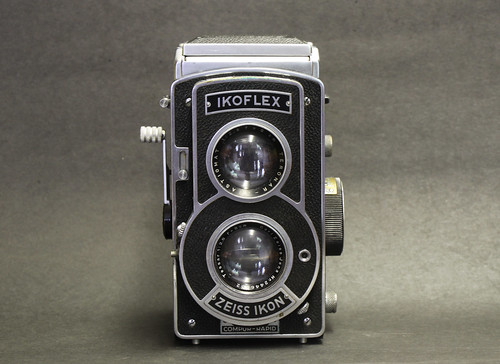Ikoflex III

|
| Ikoflex-III (853/16) image by rogal-hf (Image rights) |
The Ikoflex III (853/16) is a 6x6 120 film TLR camera that was made by Zeiss Ikon from February 1939 till January 1940. In total about 8 500 units were manufactured.[1] The camera was Zeiss Ikons attempt to equal and even surpass the Rolleiflex of Franke & Heidecke. It was priced significantly higher at 320 RM in 1939 vs. 240 RM for the Rolleiflex Automat Model 3, and had a large aperture 1:2.8 lens, two-thirds of a stop larger than the Rolleiflex and other competitors.[2][3] The film transport and shutter cocking is carried out with a crank through a complicated patented mechanism (US Patent No. 2,301,956). It has a fancy Albada Sportsfinder. According to Larry Gubas, the camera was actually similar to the previous Ikoflex II (851/16) and Ikoflex II/III (852/16) cameras, with the basic body structure and hinged body being unchanged, while the mechanism for the lever wind and the viewfinder was added.[4] Most accessories were compatible with those designed for the Super Ikonta 532/16.[5]
Contents
Specifications
- Known lens/shutter combinations :
853/16 Pcsr : Tessar 2.8/8 cm lens, in a Compur-Rapid shutter - Viewing lens: Teronar-Anastigmat f/2.8
- Albada eye-level sportsfinder.
- Double-exposure prevention.
- Blank film frame prevention.
- Automatic shutter tensioning during transport stroke.
Bibliography
- Zeiss Ikon brochure 1939, Jetzt knipsen mit Cameras von Zeiss Ikon, C875 2904 5000 239, German, page 15.
Links
- Ikoflex III user manual (pdf) at Butkus.org, 23 - 24 pgs. missing
- Zeiss Ikon Ikoflex III at Pacific Rim Camera
- Zeiss Ikon US patent 2301956 for the crank combined film transport and shutter cocking mechanism at Google Patents.
Notes
- ↑ Bernd K. Otto, Carl Zeiss Kamera-Register 1902-2012 (2012), p. 531
- ↑ Claus Prochnow, Rollei Report 1 (1993), p. 205
- ↑ Bernd K. Otto, Carl Zeiss Kamera-Register 1902-2012 (2012), p. 531
- ↑ Zeiss Historica - The Journal of the Zeiss Historica Society, Volume 5, Number 1, Spring 1983
- ↑ Zeiss Historica - The Journal of the Zeiss Historica Society, Volume 5, Number 1, Spring 1983